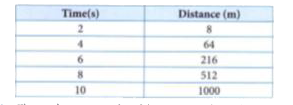When a body is moving uniformly along a straight line and there is no force of friction, acceleration/retardation of the body. According to Newton's second law of motion, the magnitude of force acting on a body is the product of mass and acceleration of the body
The distance - time table of an object in motion is given below

The force acting on the object
increases
decreases
remains unchanged
none of these
The correct Answer is:A
Forces acting on the object are increasing with time, since acceleration is increasing with time
Topper's Solved these Questions
- FOOTSTEPS TOWARDS CBSE BOARDBOOK - MTG IIT JEE FOUNDATIONCHAPTER - FOOTSTEPS TOWARDS CBSE BOARDEXERCISE - Section - B
12 Videos
- FOOTSTEPS TOWARDS CBSE BOARDBOOK - MTG IIT JEE FOUNDATIONCHAPTER - FOOTSTEPS TOWARDS CBSE BOARDEXERCISE - Section - C
16 Videos
- FOOTSTEPS TOWARDS JEE MAIN BOOK - MTG IIT JEE FOUNDATIONCHAPTER - FOOTSTEPS TOWARDS JEE MAIN EXERCISE - Section B (Numerical Value Type Questions)
10 Videos
- FOOTSTEPS TOWARDS NEETBOOK - MTG IIT JEE FOUNDATIONCHAPTER - FOOTSTEPS TOWARDS NEETEXERCISE - Multiple Choice Question
45 Videos
Similar Questions
Knowledge Check
When a body is moving uniformly along a straight line and there is no force of friction, acceleration/retardation of the body. According to Newton's second law of motion, the magnitude of force acting on a body is the product of mass and acceleration of the body
The distance - time table of an object in motion is given below

In the given table, acceleration of the object isAincreasingBdecreasingCconstantDnone of theseWhen a body is moving uniformly along a straight line and there is no force of friction, acceleration/retardation of the body. According to Newton's second law of motion, the magnitude of force acting on a body is the product of mass and acceleration of the body
The distance - time table of an object in motion is given below

Choose the correct order of the corresponding velocities of the object (in ms−1 ) in different time intervals .A16, 64, 76, 148, 244B4, 28, 76, 148, 244C244, 148, 76, 28, 4D64, 16, 76, 148, 244When a body is moving uniformly along a straight line and there is no force of friction, acceleration/retardation of the body. According to Newton's second law of motion, the magnitude of force acting on a body is the product of mass and acceleration of the body
The distance - time table of an object in motion is given below

Which among the Newton's laws of motion can be used to calculate the force acting on the object in motion ?AFirst lawBSecond lawCThird lawDnone of these
One newton force is ……..produce an acceleration of…….in a body of……. .
View SolutionWhen a body is moving uniformly along a straight line and there is no force of friction, acceleration/retardation of the body. According to Newton's second law of motion, the magnitude of force acting on a body is the product of mass and acceleration of the body
The distance - time table of an object in motion is given below

A passenger in a moving train tosses a coin which falls behind him. This shows that the motion of train is
View SolutionWhen a force of 1N acts on a body of mass 1 gram, the body receives an acceleration of
View SolutionAssertion: If external force on a body is zero, its acceleration is zero.
Reason: This is the simple from of Newton's second law of motion.
View SolutionAssertion: If external force on a body is zero, its acceleration is zero.
Reason: This is the simple from of Newton's second law of motion.
View Solution
